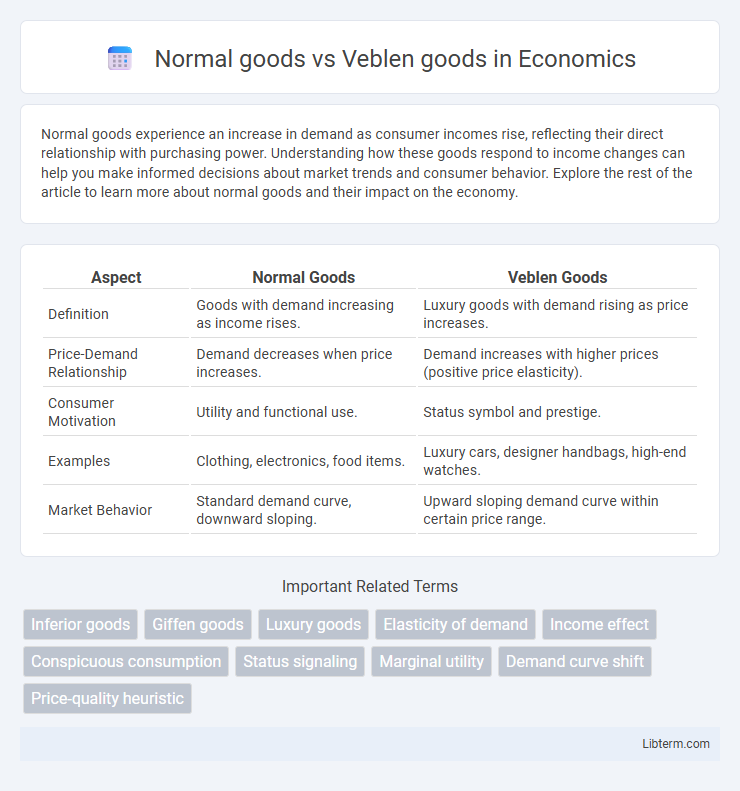Normal goods experience an increase in demand as consumer incomes rise, reflecting their direct relationship with purchasing power. Understanding how these goods respond to income changes can help you make informed decisions about market trends and consumer behavior. Explore the rest of the article to learn more about normal goods and their impact on the economy.
Table of Comparison
| Aspect | Normal Goods | Veblen Goods |
|---|---|---|
| Definition | Goods with demand increasing as income rises. | Luxury goods with demand rising as price increases. |
| Price-Demand Relationship | Demand decreases when price increases. | Demand increases with higher prices (positive price elasticity). |
| Consumer Motivation | Utility and functional use. | Status symbol and prestige. |
| Examples | Clothing, electronics, food items. | Luxury cars, designer handbags, high-end watches. |
| Market Behavior | Standard demand curve, downward sloping. | Upward sloping demand curve within certain price range. |
Introduction to Normal Goods and Veblen Goods
Normal goods exhibit increased consumer demand as income rises, reflecting typical purchasing behavior aligned with economic theory. Veblen goods, however, experience higher demand with increased prices due to their status symbol appeal, defying standard demand curves. These distinctions highlight consumer preference dynamics and market segmentation based on income effects and perceived prestige.
Defining Normal Goods: Key Characteristics
Normal goods are products for which demand increases as consumer income rises, reflecting a positive income elasticity of demand. These goods typically include everyday items such as clothing, household appliances, and dining services that consumers buy more of when their purchasing power grows. Unlike Veblen goods, which gain appeal through status signaling and exclusive pricing, normal goods emphasize practical utility and affordability within changing economic conditions.
Understanding Veblen Goods: Unique Features
Veblen goods are luxury items whose demand increases as their price rises, defying the typical law of demand observed in normal goods, where higher prices usually lead to lower demand. These goods exhibit a unique status symbol effect, where exclusivity and visible wealth showcase drive consumer preference, making price a key factor in perceived value rather than affordability. Understanding Veblen goods involves recognizing the interplay of consumer psychology, brand prestige, and social signaling that creates demand independent of utility or functional value.
Income Effect on Normal Goods
Normal goods exhibit a positive income effect, meaning that as consumers' income increases, the demand for these goods rises accordingly. This behavior contrasts with inferior goods, where demand decreases with income growth. The income elasticity of demand for normal goods is positive, reflecting their sensitivity to changes in consumer purchasing power.
Price and Demand Relationship in Veblen Goods
Veblen goods exhibit a unique price and demand relationship where demand increases as prices rise, defying the typical downward-sloping demand curve observed in normal goods. This phenomenon occurs because higher prices enhance the perceived exclusivity and status symbol value of Veblen goods, attracting consumers seeking prestige. Examples include luxury brands like designer handbags, high-end watches, and exclusive automobiles, where elevated prices directly bolster demand through social signaling.
Consumer Behavior: Normal vs Veblen Goods
Normal goods experience increased consumer demand as income rises, reflecting typical purchasing behavior driven by utility and necessity. Veblen goods defy standard demand patterns by gaining appeal through higher prices, symbolizing status and exclusivity in consumer behavior. Understanding these distinctions is crucial for marketers targeting income-sensitive segments versus prestige-oriented customers.
Real-World Examples of Normal Goods
Normal goods, such as fresh fruits, clothing, and electronics, experience increased demand as consumer incomes rise, reflecting a positive income elasticity. For instance, organic produce sales grow consistently in affluent markets, highlighting their status as normal goods. In contrast to Veblen goods like luxury watches, which see higher demand as prices rise due to their status symbol appeal, normal goods maintain stable demand patterns linked closely to income changes rather than price-driven prestige.
Luxurious Status: Examples of Veblen Goods
Veblen goods, exemplified by luxury watches, designer handbags, and high-end sports cars, defy typical economic demand patterns as their desirability increases with higher prices, reflecting their role as status symbols. Unlike normal goods, whose consumption grows with rising income but decreases when prices go up, Veblen goods attract consumers precisely because their elevated costs signal exclusivity and prestige. Brands such as Rolex, Hermes, and Ferrari illustrate the luxurious status effect, where the value perceived is deeply tied to social standing and conspicuous consumption.
Market Implications and Economic Insights
Normal goods experience increased demand as consumer income rises, reflecting typical purchasing behavior and enabling stable market growth predictions. Veblen goods defy conventional demand patterns by gaining appeal through higher prices, signifying status and exclusivity that drive luxury market dynamics. Understanding these distinctions aids businesses in pricing strategies and policymakers in forecasting consumption trends under varying economic conditions.
Conclusion: Key Differences and Impacts
Normal goods experience increased demand as consumer income rises, reflecting typical purchasing behavior driven by utility and affordability. Veblen goods, conversely, witness higher demand with increased prices as they serve as status symbols, appealing primarily to consumers seeking prestige and exclusivity. These key differences impact market strategies, with normal goods focusing on income elasticity and Veblen goods leveraging price perception to drive desirability.
Normal goods Infographic

 libterm.com
libterm.com